Report on Contract, Negligence, and Tortious Liability in Business
VerifiedAdded on 2019/12/17
|12
|4423
|162
Report
AI Summary
This report comprehensively explores the legal aspects of contracts and negligence within a business context. It begins with an introduction to contract formation, detailing essential elements such as offer, acceptance, consideration, consensus ad idem, and the capacity of parties. The report then categorizes different forms of contracts and their impacts, including face-to-face, written, and distance selling contracts. Furthermore, it analyzes contract terms like conditions, warranties, in-nominate terms, and exclusion clauses. The report then transitions to the Law of Torts, specifically focusing on negligence and vicarious liability, applying these concepts to various business scenarios through case studies. Case studies examine the enforceability of contracts, application of contract terms, and the validity of exclusion clauses. The report concludes with a discussion of contract liability versus tortious liability, providing a detailed analysis of the legal principles involved.
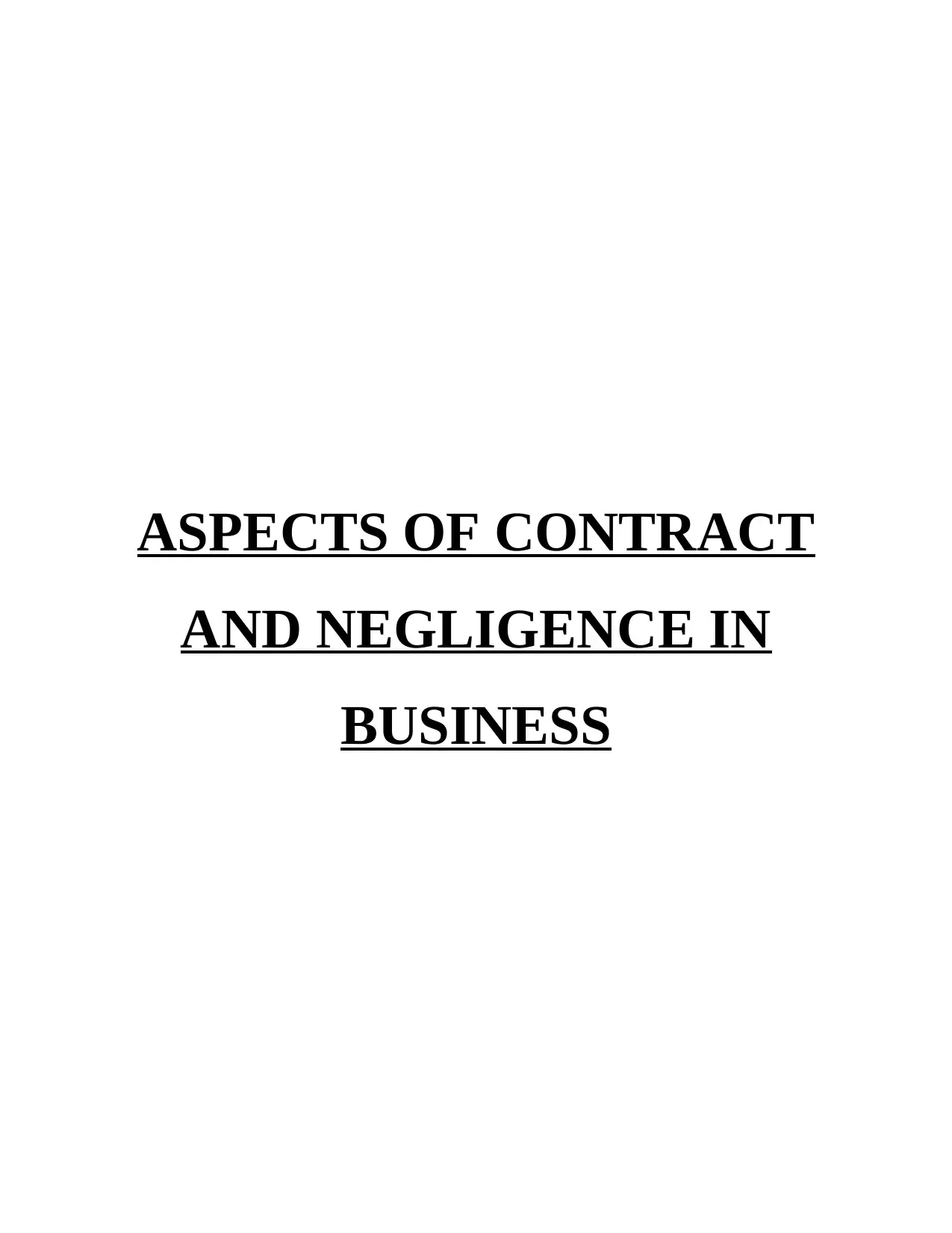
ASPECTS OF CONTRACT
AND NEGLIGENCE IN
BUSINESS
AND NEGLIGENCE IN
BUSINESS
Paraphrase This Document
Need a fresh take? Get an instant paraphrase of this document with our AI Paraphraser

TABLE OF CONTENTS
INTRODUCTION...........................................................................................................................1
TASK 1............................................................................................................................................1
1.1 Importance of various elements of contract.....................................................................1
1.2 Impact of different forms of contract...............................................................................2
1.3 Terms of Contract.............................................................................................................3
TASK 2............................................................................................................................................4
2.1 Application of essential elements.....................................................................................4
2.2 Application of Terms of contract.....................................................................................5
2.3 Effects of various Terms..................................................................................................5
TASK 3............................................................................................................................................6
3.1 Contract Liability against Tortious Liability....................................................................6
3.2 Negligence and its elements.............................................................................................6
3.3 Vicarious Liability...........................................................................................................7
TASK 4............................................................................................................................................8
4.1 Application of elements of Tort.......................................................................................8
4.2 Application of elements of Vicarious Liability................................................................8
CONCLUSION ...............................................................................................................................9
REFERECNES..............................................................................................................................10
INTRODUCTION...........................................................................................................................1
TASK 1............................................................................................................................................1
1.1 Importance of various elements of contract.....................................................................1
1.2 Impact of different forms of contract...............................................................................2
1.3 Terms of Contract.............................................................................................................3
TASK 2............................................................................................................................................4
2.1 Application of essential elements.....................................................................................4
2.2 Application of Terms of contract.....................................................................................5
2.3 Effects of various Terms..................................................................................................5
TASK 3............................................................................................................................................6
3.1 Contract Liability against Tortious Liability....................................................................6
3.2 Negligence and its elements.............................................................................................6
3.3 Vicarious Liability...........................................................................................................7
TASK 4............................................................................................................................................8
4.1 Application of elements of Tort.......................................................................................8
4.2 Application of elements of Vicarious Liability................................................................8
CONCLUSION ...............................................................................................................................9
REFERECNES..............................................................................................................................10
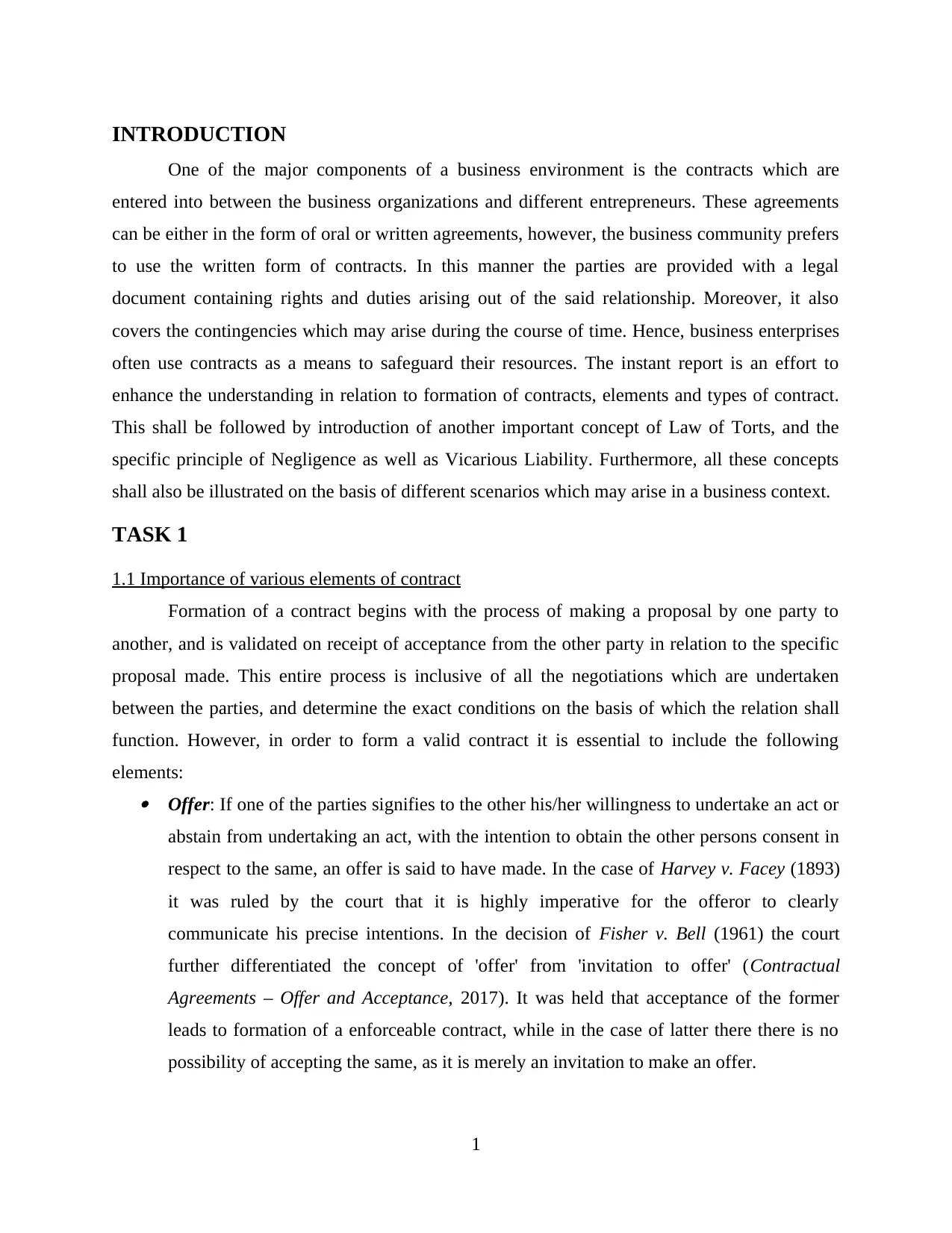
INTRODUCTION
One of the major components of a business environment is the contracts which are
entered into between the business organizations and different entrepreneurs. These agreements
can be either in the form of oral or written agreements, however, the business community prefers
to use the written form of contracts. In this manner the parties are provided with a legal
document containing rights and duties arising out of the said relationship. Moreover, it also
covers the contingencies which may arise during the course of time. Hence, business enterprises
often use contracts as a means to safeguard their resources. The instant report is an effort to
enhance the understanding in relation to formation of contracts, elements and types of contract.
This shall be followed by introduction of another important concept of Law of Torts, and the
specific principle of Negligence as well as Vicarious Liability. Furthermore, all these concepts
shall also be illustrated on the basis of different scenarios which may arise in a business context.
TASK 1
1.1 Importance of various elements of contract
Formation of a contract begins with the process of making a proposal by one party to
another, and is validated on receipt of acceptance from the other party in relation to the specific
proposal made. This entire process is inclusive of all the negotiations which are undertaken
between the parties, and determine the exact conditions on the basis of which the relation shall
function. However, in order to form a valid contract it is essential to include the following
elements: Offer: If one of the parties signifies to the other his/her willingness to undertake an act or
abstain from undertaking an act, with the intention to obtain the other persons consent in
respect to the same, an offer is said to have made. In the case of Harvey v. Facey (1893)
it was ruled by the court that it is highly imperative for the offeror to clearly
communicate his precise intentions. In the decision of Fisher v. Bell (1961) the court
further differentiated the concept of 'offer' from 'invitation to offer' (Contractual
Agreements – Offer and Acceptance, 2017). It was held that acceptance of the former
leads to formation of a enforceable contract, while in the case of latter there there is no
possibility of accepting the same, as it is merely an invitation to make an offer.
1
One of the major components of a business environment is the contracts which are
entered into between the business organizations and different entrepreneurs. These agreements
can be either in the form of oral or written agreements, however, the business community prefers
to use the written form of contracts. In this manner the parties are provided with a legal
document containing rights and duties arising out of the said relationship. Moreover, it also
covers the contingencies which may arise during the course of time. Hence, business enterprises
often use contracts as a means to safeguard their resources. The instant report is an effort to
enhance the understanding in relation to formation of contracts, elements and types of contract.
This shall be followed by introduction of another important concept of Law of Torts, and the
specific principle of Negligence as well as Vicarious Liability. Furthermore, all these concepts
shall also be illustrated on the basis of different scenarios which may arise in a business context.
TASK 1
1.1 Importance of various elements of contract
Formation of a contract begins with the process of making a proposal by one party to
another, and is validated on receipt of acceptance from the other party in relation to the specific
proposal made. This entire process is inclusive of all the negotiations which are undertaken
between the parties, and determine the exact conditions on the basis of which the relation shall
function. However, in order to form a valid contract it is essential to include the following
elements: Offer: If one of the parties signifies to the other his/her willingness to undertake an act or
abstain from undertaking an act, with the intention to obtain the other persons consent in
respect to the same, an offer is said to have made. In the case of Harvey v. Facey (1893)
it was ruled by the court that it is highly imperative for the offeror to clearly
communicate his precise intentions. In the decision of Fisher v. Bell (1961) the court
further differentiated the concept of 'offer' from 'invitation to offer' (Contractual
Agreements – Offer and Acceptance, 2017). It was held that acceptance of the former
leads to formation of a enforceable contract, while in the case of latter there there is no
possibility of accepting the same, as it is merely an invitation to make an offer.
1
⊘ This is a preview!⊘
Do you want full access?
Subscribe today to unlock all pages.

Trusted by 1+ million students worldwide
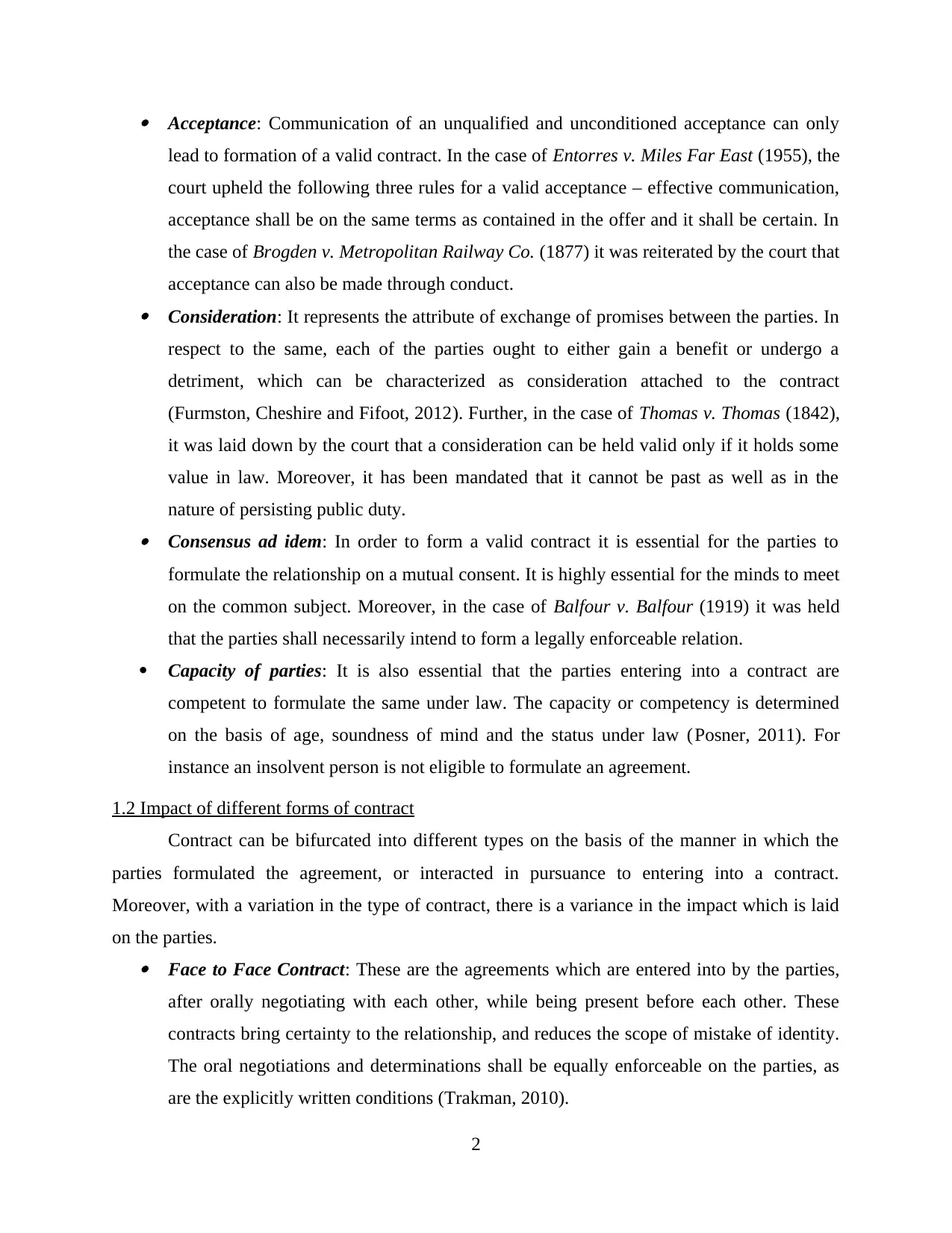
Acceptance: Communication of an unqualified and unconditioned acceptance can only
lead to formation of a valid contract. In the case of Entorres v. Miles Far East (1955), the
court upheld the following three rules for a valid acceptance – effective communication,
acceptance shall be on the same terms as contained in the offer and it shall be certain. In
the case of Brogden v. Metropolitan Railway Co. (1877) it was reiterated by the court that
acceptance can also be made through conduct. Consideration: It represents the attribute of exchange of promises between the parties. In
respect to the same, each of the parties ought to either gain a benefit or undergo a
detriment, which can be characterized as consideration attached to the contract
(Furmston, Cheshire and Fifoot, 2012). Further, in the case of Thomas v. Thomas (1842),
it was laid down by the court that a consideration can be held valid only if it holds some
value in law. Moreover, it has been mandated that it cannot be past as well as in the
nature of persisting public duty. Consensus ad idem: In order to form a valid contract it is essential for the parties to
formulate the relationship on a mutual consent. It is highly essential for the minds to meet
on the common subject. Moreover, in the case of Balfour v. Balfour (1919) it was held
that the parties shall necessarily intend to form a legally enforceable relation.
Capacity of parties: It is also essential that the parties entering into a contract are
competent to formulate the same under law. The capacity or competency is determined
on the basis of age, soundness of mind and the status under law (Posner, 2011). For
instance an insolvent person is not eligible to formulate an agreement.
1.2 Impact of different forms of contract
Contract can be bifurcated into different types on the basis of the manner in which the
parties formulated the agreement, or interacted in pursuance to entering into a contract.
Moreover, with a variation in the type of contract, there is a variance in the impact which is laid
on the parties. Face to Face Contract: These are the agreements which are entered into by the parties,
after orally negotiating with each other, while being present before each other. These
contracts bring certainty to the relationship, and reduces the scope of mistake of identity.
The oral negotiations and determinations shall be equally enforceable on the parties, as
are the explicitly written conditions (Trakman, 2010).
2
lead to formation of a valid contract. In the case of Entorres v. Miles Far East (1955), the
court upheld the following three rules for a valid acceptance – effective communication,
acceptance shall be on the same terms as contained in the offer and it shall be certain. In
the case of Brogden v. Metropolitan Railway Co. (1877) it was reiterated by the court that
acceptance can also be made through conduct. Consideration: It represents the attribute of exchange of promises between the parties. In
respect to the same, each of the parties ought to either gain a benefit or undergo a
detriment, which can be characterized as consideration attached to the contract
(Furmston, Cheshire and Fifoot, 2012). Further, in the case of Thomas v. Thomas (1842),
it was laid down by the court that a consideration can be held valid only if it holds some
value in law. Moreover, it has been mandated that it cannot be past as well as in the
nature of persisting public duty. Consensus ad idem: In order to form a valid contract it is essential for the parties to
formulate the relationship on a mutual consent. It is highly essential for the minds to meet
on the common subject. Moreover, in the case of Balfour v. Balfour (1919) it was held
that the parties shall necessarily intend to form a legally enforceable relation.
Capacity of parties: It is also essential that the parties entering into a contract are
competent to formulate the same under law. The capacity or competency is determined
on the basis of age, soundness of mind and the status under law (Posner, 2011). For
instance an insolvent person is not eligible to formulate an agreement.
1.2 Impact of different forms of contract
Contract can be bifurcated into different types on the basis of the manner in which the
parties formulated the agreement, or interacted in pursuance to entering into a contract.
Moreover, with a variation in the type of contract, there is a variance in the impact which is laid
on the parties. Face to Face Contract: These are the agreements which are entered into by the parties,
after orally negotiating with each other, while being present before each other. These
contracts bring certainty to the relationship, and reduces the scope of mistake of identity.
The oral negotiations and determinations shall be equally enforceable on the parties, as
are the explicitly written conditions (Trakman, 2010).
2
Paraphrase This Document
Need a fresh take? Get an instant paraphrase of this document with our AI Paraphraser
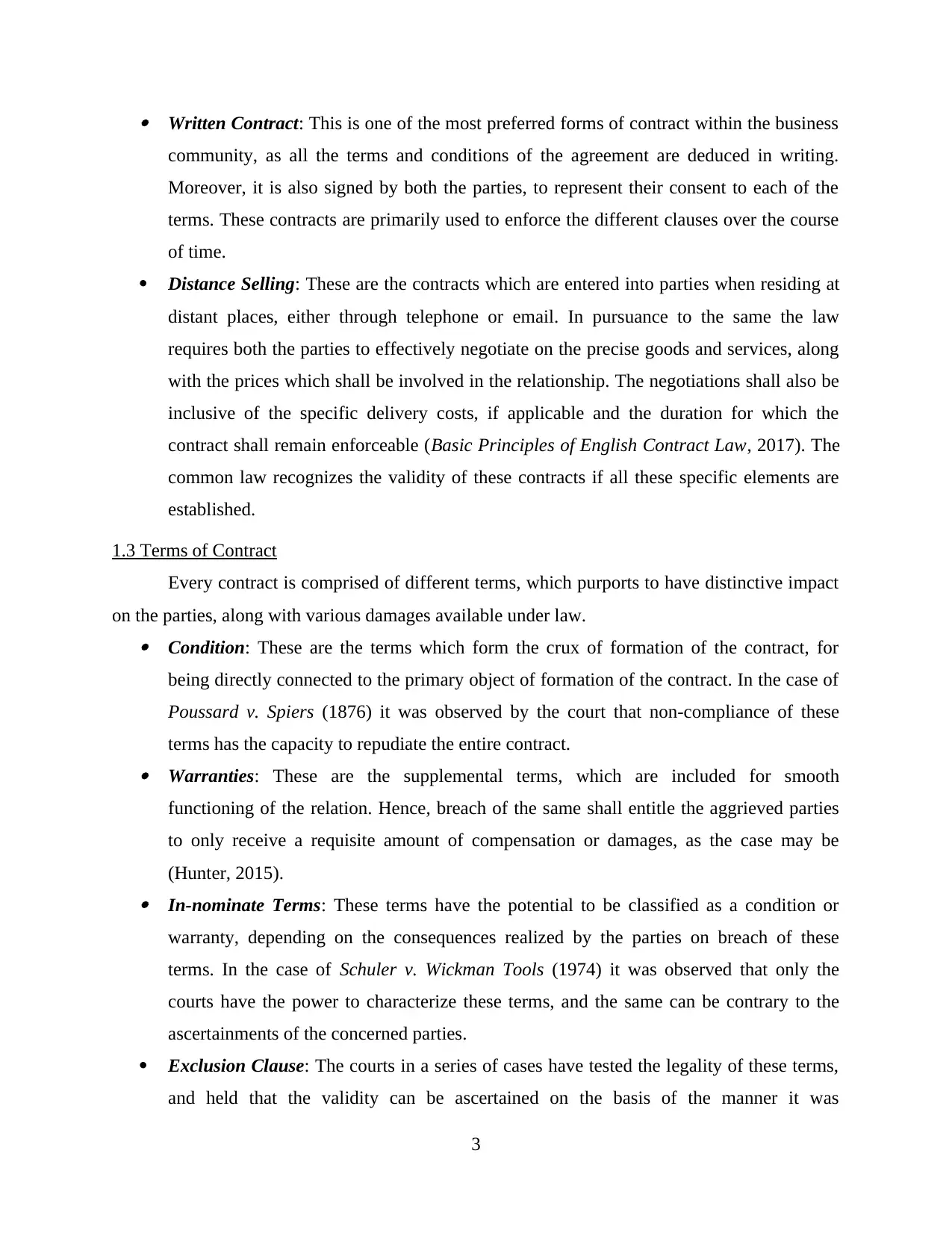
Written Contract: This is one of the most preferred forms of contract within the business
community, as all the terms and conditions of the agreement are deduced in writing.
Moreover, it is also signed by both the parties, to represent their consent to each of the
terms. These contracts are primarily used to enforce the different clauses over the course
of time.
Distance Selling: These are the contracts which are entered into parties when residing at
distant places, either through telephone or email. In pursuance to the same the law
requires both the parties to effectively negotiate on the precise goods and services, along
with the prices which shall be involved in the relationship. The negotiations shall also be
inclusive of the specific delivery costs, if applicable and the duration for which the
contract shall remain enforceable (Basic Principles of English Contract Law, 2017). The
common law recognizes the validity of these contracts if all these specific elements are
established.
1.3 Terms of Contract
Every contract is comprised of different terms, which purports to have distinctive impact
on the parties, along with various damages available under law. Condition: These are the terms which form the crux of formation of the contract, for
being directly connected to the primary object of formation of the contract. In the case of
Poussard v. Spiers (1876) it was observed by the court that non-compliance of these
terms has the capacity to repudiate the entire contract. Warranties: These are the supplemental terms, which are included for smooth
functioning of the relation. Hence, breach of the same shall entitle the aggrieved parties
to only receive a requisite amount of compensation or damages, as the case may be
(Hunter, 2015). In-nominate Terms: These terms have the potential to be classified as a condition or
warranty, depending on the consequences realized by the parties on breach of these
terms. In the case of Schuler v. Wickman Tools (1974) it was observed that only the
courts have the power to characterize these terms, and the same can be contrary to the
ascertainments of the concerned parties.
Exclusion Clause: The courts in a series of cases have tested the legality of these terms,
and held that the validity can be ascertained on the basis of the manner it was
3
community, as all the terms and conditions of the agreement are deduced in writing.
Moreover, it is also signed by both the parties, to represent their consent to each of the
terms. These contracts are primarily used to enforce the different clauses over the course
of time.
Distance Selling: These are the contracts which are entered into parties when residing at
distant places, either through telephone or email. In pursuance to the same the law
requires both the parties to effectively negotiate on the precise goods and services, along
with the prices which shall be involved in the relationship. The negotiations shall also be
inclusive of the specific delivery costs, if applicable and the duration for which the
contract shall remain enforceable (Basic Principles of English Contract Law, 2017). The
common law recognizes the validity of these contracts if all these specific elements are
established.
1.3 Terms of Contract
Every contract is comprised of different terms, which purports to have distinctive impact
on the parties, along with various damages available under law. Condition: These are the terms which form the crux of formation of the contract, for
being directly connected to the primary object of formation of the contract. In the case of
Poussard v. Spiers (1876) it was observed by the court that non-compliance of these
terms has the capacity to repudiate the entire contract. Warranties: These are the supplemental terms, which are included for smooth
functioning of the relation. Hence, breach of the same shall entitle the aggrieved parties
to only receive a requisite amount of compensation or damages, as the case may be
(Hunter, 2015). In-nominate Terms: These terms have the potential to be classified as a condition or
warranty, depending on the consequences realized by the parties on breach of these
terms. In the case of Schuler v. Wickman Tools (1974) it was observed that only the
courts have the power to characterize these terms, and the same can be contrary to the
ascertainments of the concerned parties.
Exclusion Clause: The courts in a series of cases have tested the legality of these terms,
and held that the validity can be ascertained on the basis of the manner it was
3
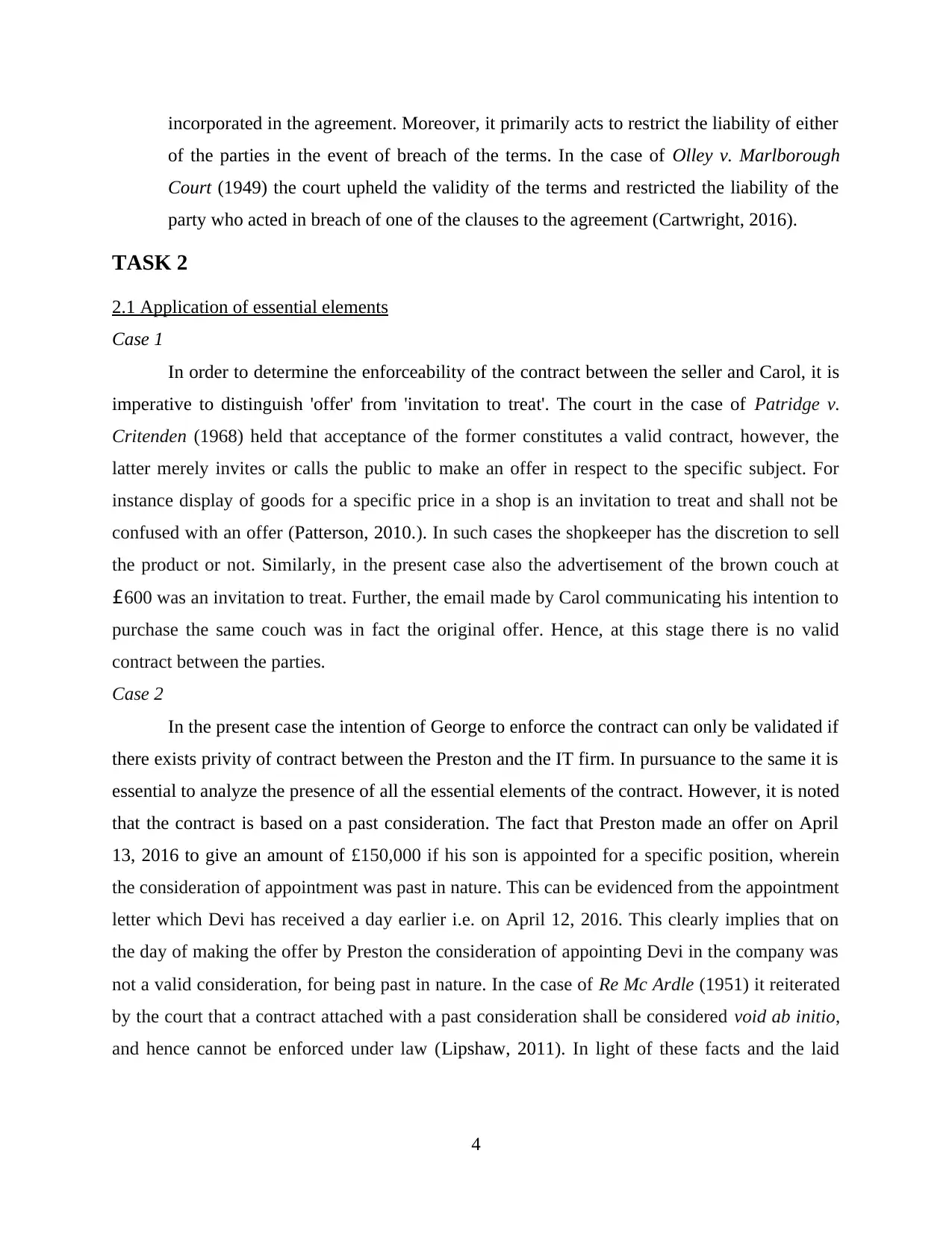
incorporated in the agreement. Moreover, it primarily acts to restrict the liability of either
of the parties in the event of breach of the terms. In the case of Olley v. Marlborough
Court (1949) the court upheld the validity of the terms and restricted the liability of the
party who acted in breach of one of the clauses to the agreement (Cartwright, 2016).
TASK 2
2.1 Application of essential elements
Case 1
In order to determine the enforceability of the contract between the seller and Carol, it is
imperative to distinguish 'offer' from 'invitation to treat'. The court in the case of Patridge v.
Critenden (1968) held that acceptance of the former constitutes a valid contract, however, the
latter merely invites or calls the public to make an offer in respect to the specific subject. For
instance display of goods for a specific price in a shop is an invitation to treat and shall not be
confused with an offer (Patterson, 2010.). In such cases the shopkeeper has the discretion to sell
the product or not. Similarly, in the present case also the advertisement of the brown couch at
£600 was an invitation to treat. Further, the email made by Carol communicating his intention to
purchase the same couch was in fact the original offer. Hence, at this stage there is no valid
contract between the parties.
Case 2
In the present case the intention of George to enforce the contract can only be validated if
there exists privity of contract between the Preston and the IT firm. In pursuance to the same it is
essential to analyze the presence of all the essential elements of the contract. However, it is noted
that the contract is based on a past consideration. The fact that Preston made an offer on April
13, 2016 to give an amount of £150,000 if his son is appointed for a specific position, wherein
the consideration of appointment was past in nature. This can be evidenced from the appointment
letter which Devi has received a day earlier i.e. on April 12, 2016. This clearly implies that on
the day of making the offer by Preston the consideration of appointing Devi in the company was
not a valid consideration, for being past in nature. In the case of Re Mc Ardle (1951) it reiterated
by the court that a contract attached with a past consideration shall be considered void ab initio,
and hence cannot be enforced under law (Lipshaw, 2011). In light of these facts and the laid
4
of the parties in the event of breach of the terms. In the case of Olley v. Marlborough
Court (1949) the court upheld the validity of the terms and restricted the liability of the
party who acted in breach of one of the clauses to the agreement (Cartwright, 2016).
TASK 2
2.1 Application of essential elements
Case 1
In order to determine the enforceability of the contract between the seller and Carol, it is
imperative to distinguish 'offer' from 'invitation to treat'. The court in the case of Patridge v.
Critenden (1968) held that acceptance of the former constitutes a valid contract, however, the
latter merely invites or calls the public to make an offer in respect to the specific subject. For
instance display of goods for a specific price in a shop is an invitation to treat and shall not be
confused with an offer (Patterson, 2010.). In such cases the shopkeeper has the discretion to sell
the product or not. Similarly, in the present case also the advertisement of the brown couch at
£600 was an invitation to treat. Further, the email made by Carol communicating his intention to
purchase the same couch was in fact the original offer. Hence, at this stage there is no valid
contract between the parties.
Case 2
In the present case the intention of George to enforce the contract can only be validated if
there exists privity of contract between the Preston and the IT firm. In pursuance to the same it is
essential to analyze the presence of all the essential elements of the contract. However, it is noted
that the contract is based on a past consideration. The fact that Preston made an offer on April
13, 2016 to give an amount of £150,000 if his son is appointed for a specific position, wherein
the consideration of appointment was past in nature. This can be evidenced from the appointment
letter which Devi has received a day earlier i.e. on April 12, 2016. This clearly implies that on
the day of making the offer by Preston the consideration of appointing Devi in the company was
not a valid consideration, for being past in nature. In the case of Re Mc Ardle (1951) it reiterated
by the court that a contract attached with a past consideration shall be considered void ab initio,
and hence cannot be enforced under law (Lipshaw, 2011). In light of these facts and the laid
4
⊘ This is a preview!⊘
Do you want full access?
Subscribe today to unlock all pages.

Trusted by 1+ million students worldwide
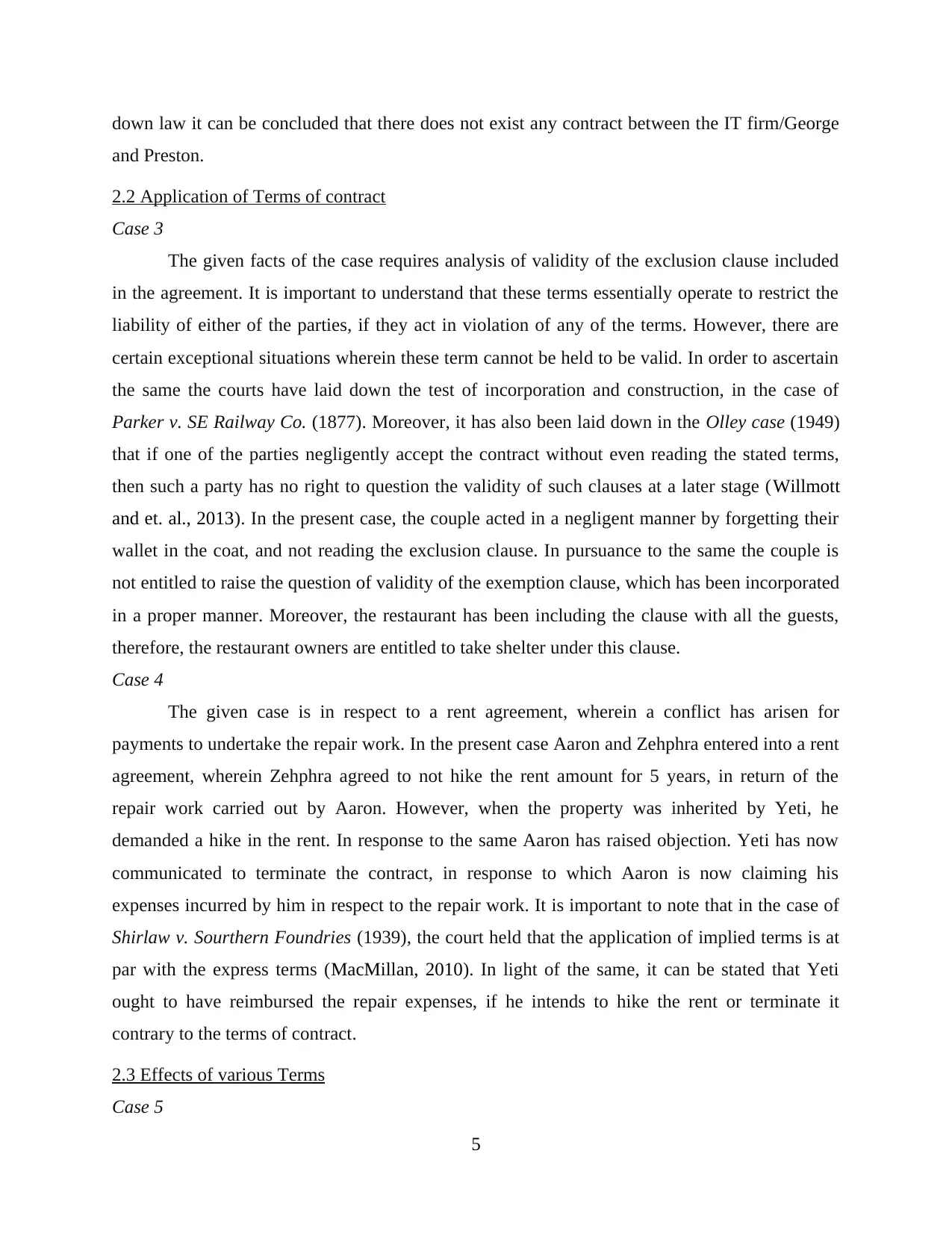
down law it can be concluded that there does not exist any contract between the IT firm/George
and Preston.
2.2 Application of Terms of contract
Case 3
The given facts of the case requires analysis of validity of the exclusion clause included
in the agreement. It is important to understand that these terms essentially operate to restrict the
liability of either of the parties, if they act in violation of any of the terms. However, there are
certain exceptional situations wherein these term cannot be held to be valid. In order to ascertain
the same the courts have laid down the test of incorporation and construction, in the case of
Parker v. SE Railway Co. (1877). Moreover, it has also been laid down in the Olley case (1949)
that if one of the parties negligently accept the contract without even reading the stated terms,
then such a party has no right to question the validity of such clauses at a later stage (Willmott
and et. al., 2013). In the present case, the couple acted in a negligent manner by forgetting their
wallet in the coat, and not reading the exclusion clause. In pursuance to the same the couple is
not entitled to raise the question of validity of the exemption clause, which has been incorporated
in a proper manner. Moreover, the restaurant has been including the clause with all the guests,
therefore, the restaurant owners are entitled to take shelter under this clause.
Case 4
The given case is in respect to a rent agreement, wherein a conflict has arisen for
payments to undertake the repair work. In the present case Aaron and Zehphra entered into a rent
agreement, wherein Zehphra agreed to not hike the rent amount for 5 years, in return of the
repair work carried out by Aaron. However, when the property was inherited by Yeti, he
demanded a hike in the rent. In response to the same Aaron has raised objection. Yeti has now
communicated to terminate the contract, in response to which Aaron is now claiming his
expenses incurred by him in respect to the repair work. It is important to note that in the case of
Shirlaw v. Sourthern Foundries (1939), the court held that the application of implied terms is at
par with the express terms (MacMillan, 2010). In light of the same, it can be stated that Yeti
ought to have reimbursed the repair expenses, if he intends to hike the rent or terminate it
contrary to the terms of contract.
2.3 Effects of various Terms
Case 5
5
and Preston.
2.2 Application of Terms of contract
Case 3
The given facts of the case requires analysis of validity of the exclusion clause included
in the agreement. It is important to understand that these terms essentially operate to restrict the
liability of either of the parties, if they act in violation of any of the terms. However, there are
certain exceptional situations wherein these term cannot be held to be valid. In order to ascertain
the same the courts have laid down the test of incorporation and construction, in the case of
Parker v. SE Railway Co. (1877). Moreover, it has also been laid down in the Olley case (1949)
that if one of the parties negligently accept the contract without even reading the stated terms,
then such a party has no right to question the validity of such clauses at a later stage (Willmott
and et. al., 2013). In the present case, the couple acted in a negligent manner by forgetting their
wallet in the coat, and not reading the exclusion clause. In pursuance to the same the couple is
not entitled to raise the question of validity of the exemption clause, which has been incorporated
in a proper manner. Moreover, the restaurant has been including the clause with all the guests,
therefore, the restaurant owners are entitled to take shelter under this clause.
Case 4
The given case is in respect to a rent agreement, wherein a conflict has arisen for
payments to undertake the repair work. In the present case Aaron and Zehphra entered into a rent
agreement, wherein Zehphra agreed to not hike the rent amount for 5 years, in return of the
repair work carried out by Aaron. However, when the property was inherited by Yeti, he
demanded a hike in the rent. In response to the same Aaron has raised objection. Yeti has now
communicated to terminate the contract, in response to which Aaron is now claiming his
expenses incurred by him in respect to the repair work. It is important to note that in the case of
Shirlaw v. Sourthern Foundries (1939), the court held that the application of implied terms is at
par with the express terms (MacMillan, 2010). In light of the same, it can be stated that Yeti
ought to have reimbursed the repair expenses, if he intends to hike the rent or terminate it
contrary to the terms of contract.
2.3 Effects of various Terms
Case 5
5
Paraphrase This Document
Need a fresh take? Get an instant paraphrase of this document with our AI Paraphraser

In accordance to the given scenario it can be state that the requirement of disclosing the
said information constituted to be a condition. As held in Poussard v. Spiers (1876) violation of a
condition leads to repudiation of the entire contract. In light of this law, it can be said that the
fact that policyholder failed to disclose the information in connection to the prior claims,
amounted to a clear breach of the condition. Therefore, the insurer in the present case is entitiled
to repudiate the insurance policy, in accordance to the Common Law.
Case 6
As per the provided facts the policyholder failed to disclose the required information in
the rightful manner. This is a clear breach of the condition, and in light of the law laid down in
Poussard case (1876), this entitles the aggrieved party to make the contract void ab initio
(Calleros, 2011). However, it is also clear from the fact that while filing the form she completely
acted in good faith, and was unaware of the modifications which were undertaken on the car and
also that her husband had made certain claims within the stipulated time. Thus, these facts make
the policyholder to claim the defence of ignorance of law, which is a valid defence under the
Common Law.
TASK 3
3.1 Contract Liability against Tortious Liability
Contractual Liability Tortious Liability
It is a civil liability, entitling the aggrieved
party to receive damages
Similarly, this is also a civil liability with the
potential to raise the responsibility for giving
damages.
The damages given are liquidated in nature. However, these un-liquidated in nature.
Privity of contract is an essential element No such requirement for imposing this liability
Law of Contract is the governing law, which
has enumerated as statute (Van Dam, 2013).
Law of Tort governs this liability, and is
completely based on judicial pronouncements.
Application on majority of interactions in the
business world.
Application on the general public, in the event
of breach of duty of care.
6
said information constituted to be a condition. As held in Poussard v. Spiers (1876) violation of a
condition leads to repudiation of the entire contract. In light of this law, it can be said that the
fact that policyholder failed to disclose the information in connection to the prior claims,
amounted to a clear breach of the condition. Therefore, the insurer in the present case is entitiled
to repudiate the insurance policy, in accordance to the Common Law.
Case 6
As per the provided facts the policyholder failed to disclose the required information in
the rightful manner. This is a clear breach of the condition, and in light of the law laid down in
Poussard case (1876), this entitles the aggrieved party to make the contract void ab initio
(Calleros, 2011). However, it is also clear from the fact that while filing the form she completely
acted in good faith, and was unaware of the modifications which were undertaken on the car and
also that her husband had made certain claims within the stipulated time. Thus, these facts make
the policyholder to claim the defence of ignorance of law, which is a valid defence under the
Common Law.
TASK 3
3.1 Contract Liability against Tortious Liability
Contractual Liability Tortious Liability
It is a civil liability, entitling the aggrieved
party to receive damages
Similarly, this is also a civil liability with the
potential to raise the responsibility for giving
damages.
The damages given are liquidated in nature. However, these un-liquidated in nature.
Privity of contract is an essential element No such requirement for imposing this liability
Law of Contract is the governing law, which
has enumerated as statute (Van Dam, 2013).
Law of Tort governs this liability, and is
completely based on judicial pronouncements.
Application on majority of interactions in the
business world.
Application on the general public, in the event
of breach of duty of care.
6

3.2 Negligence and its elements
It is one of the most critical principles under Law of Torts, and was first developed by the
court in Donoghue v. Stevenson (1932). This principle is made applicable in the event any
individual fails to act in a reasonable manner, and in consequence of the same causes harm to
another person. For instance, a driver over-speeding on a congested road, and colliding with a
person, can be termed as acting in a negligent manner (Negligence, 2017). However, to establish
the negligence of an individual, it is imperative for the plaintiff to prove the following elements: Duty of Care: At the first instance it shall be established by the plaintiff that the
defendant was under a duty to act in a particular manner. For instance, the above
mentioned example of driver over speeding the car, was under a duty of care to drive
carefully, especially on such a congested road. Breach of Duty: Once the duty of care is imposed, the defendant shall be proved to have
acted in breach of the said duty. In Vaughan v. Menlove (1837) it was specifically stated
by the court that non-compliance shall be in connection to the specific obligation
imposed on the defendant. Causation of Damage: Further, a direct nexus between breach of the duty and the
damage shall be proved. There shall be a direct link between the two (Steele, 2010). For
instance, the harsh driving of the individual shall be the reason of damage caused to the
plaintiff.
Remoteness: Lastly, it shall be proved that the damage was easily foreseeable, and was
not remote in nature.
3.3 Vicarious Liability
It is a doctrine under Law of Torts which operates to make an individual or entity liable
for the negligent actions of another individual. However, it order to impose such a liability it is
essential for establishing a principal-agent relationship between the parties, which could also be
in the form of employer-employee relation. In such cases, the employer/principal can be made
liable for the negligent actions of the employee/agent if undertaken within the course of
employment. In the case of Lister v. Hesley (2001) the court pronounced that this liability is
completely strict in nature. Moreover, it has been held in the case that unauthorized actions
within the course of employment also has the potential to make the employers vicariously liable
(Coleman, 2010). This view was also supported in London General Omnibus Co. (1862),
7
It is one of the most critical principles under Law of Torts, and was first developed by the
court in Donoghue v. Stevenson (1932). This principle is made applicable in the event any
individual fails to act in a reasonable manner, and in consequence of the same causes harm to
another person. For instance, a driver over-speeding on a congested road, and colliding with a
person, can be termed as acting in a negligent manner (Negligence, 2017). However, to establish
the negligence of an individual, it is imperative for the plaintiff to prove the following elements: Duty of Care: At the first instance it shall be established by the plaintiff that the
defendant was under a duty to act in a particular manner. For instance, the above
mentioned example of driver over speeding the car, was under a duty of care to drive
carefully, especially on such a congested road. Breach of Duty: Once the duty of care is imposed, the defendant shall be proved to have
acted in breach of the said duty. In Vaughan v. Menlove (1837) it was specifically stated
by the court that non-compliance shall be in connection to the specific obligation
imposed on the defendant. Causation of Damage: Further, a direct nexus between breach of the duty and the
damage shall be proved. There shall be a direct link between the two (Steele, 2010). For
instance, the harsh driving of the individual shall be the reason of damage caused to the
plaintiff.
Remoteness: Lastly, it shall be proved that the damage was easily foreseeable, and was
not remote in nature.
3.3 Vicarious Liability
It is a doctrine under Law of Torts which operates to make an individual or entity liable
for the negligent actions of another individual. However, it order to impose such a liability it is
essential for establishing a principal-agent relationship between the parties, which could also be
in the form of employer-employee relation. In such cases, the employer/principal can be made
liable for the negligent actions of the employee/agent if undertaken within the course of
employment. In the case of Lister v. Hesley (2001) the court pronounced that this liability is
completely strict in nature. Moreover, it has been held in the case that unauthorized actions
within the course of employment also has the potential to make the employers vicariously liable
(Coleman, 2010). This view was also supported in London General Omnibus Co. (1862),
7
⊘ This is a preview!⊘
Do you want full access?
Subscribe today to unlock all pages.

Trusted by 1+ million students worldwide

wherein undertaking of an unethical action within the course of employment was considered a
valid situation to make the employer vicariously liable.
TASK 4
4.1 Application of elements of Tort
Case 7
(a) The hospital could be made liable for the negligent actions of the doctor, in the event
Mr. Brown had died either due to continuation of the chest pain or consumption of pain killers
which were prescribed by the doctor over the phone. The rationale behind the same is that the
doctor acted in a negligent manner by not seeing Mr. Brown personally, and prescribing the pain
killers over phone. In pursuance to the same the hospital could have been made vicariously liable
for the actions of doctor.
(b) However, contrary to the above stated facts, Mr. Brown died due to pneumonia
which, in fact, was caused due to presence of toxic moulds in the surroundings. In such a case
the real cause of death of Mr Brown was not the negligent action of the doctor, and hence no
nexus can be established between the breach of duty and damage. Hence, in absence of the
element of negligence, Hospital cannot be held vicariously liable.
4.2 Application of elements of Vicarious Liability
Case 8
In order to determine the liability of the Chauffeur company it is important to establish a
difference between the concepts of 'contract for service' and 'contract of service'. A similar
situation was faced by the court in the case of Hawley v. Luminar Leisure Ltd. (2006), wherein it
was held that the former is a relationship wherein the services are provided in return of a fixed
amount of payment, and there exists no other interaction (Zillman, Simmons and Gregory, 2015).
Thus, there is no scope of imposing vicarious liability in such a relationship. However, the latter
is the case wherein one individual acts on behalf of the other and acts under the supervision of
the other. In light of this distinction it can be stated that in the present case, the driver was
working under the supervision and instruction of the Chauffeur company, and thus there relation
can be characterized as a contract of service. Moreover, in such a case the employer can be made
vicariously liable for the negligent actions of the employee. Furthermore, the fact that he was
drunk during the working hours is an unauthorized act which is undertaken within the course of
8
valid situation to make the employer vicariously liable.
TASK 4
4.1 Application of elements of Tort
Case 7
(a) The hospital could be made liable for the negligent actions of the doctor, in the event
Mr. Brown had died either due to continuation of the chest pain or consumption of pain killers
which were prescribed by the doctor over the phone. The rationale behind the same is that the
doctor acted in a negligent manner by not seeing Mr. Brown personally, and prescribing the pain
killers over phone. In pursuance to the same the hospital could have been made vicariously liable
for the actions of doctor.
(b) However, contrary to the above stated facts, Mr. Brown died due to pneumonia
which, in fact, was caused due to presence of toxic moulds in the surroundings. In such a case
the real cause of death of Mr Brown was not the negligent action of the doctor, and hence no
nexus can be established between the breach of duty and damage. Hence, in absence of the
element of negligence, Hospital cannot be held vicariously liable.
4.2 Application of elements of Vicarious Liability
Case 8
In order to determine the liability of the Chauffeur company it is important to establish a
difference between the concepts of 'contract for service' and 'contract of service'. A similar
situation was faced by the court in the case of Hawley v. Luminar Leisure Ltd. (2006), wherein it
was held that the former is a relationship wherein the services are provided in return of a fixed
amount of payment, and there exists no other interaction (Zillman, Simmons and Gregory, 2015).
Thus, there is no scope of imposing vicarious liability in such a relationship. However, the latter
is the case wherein one individual acts on behalf of the other and acts under the supervision of
the other. In light of this distinction it can be stated that in the present case, the driver was
working under the supervision and instruction of the Chauffeur company, and thus there relation
can be characterized as a contract of service. Moreover, in such a case the employer can be made
vicariously liable for the negligent actions of the employee. Furthermore, the fact that he was
drunk during the working hours is an unauthorized act which is undertaken within the course of
8
Paraphrase This Document
Need a fresh take? Get an instant paraphrase of this document with our AI Paraphraser
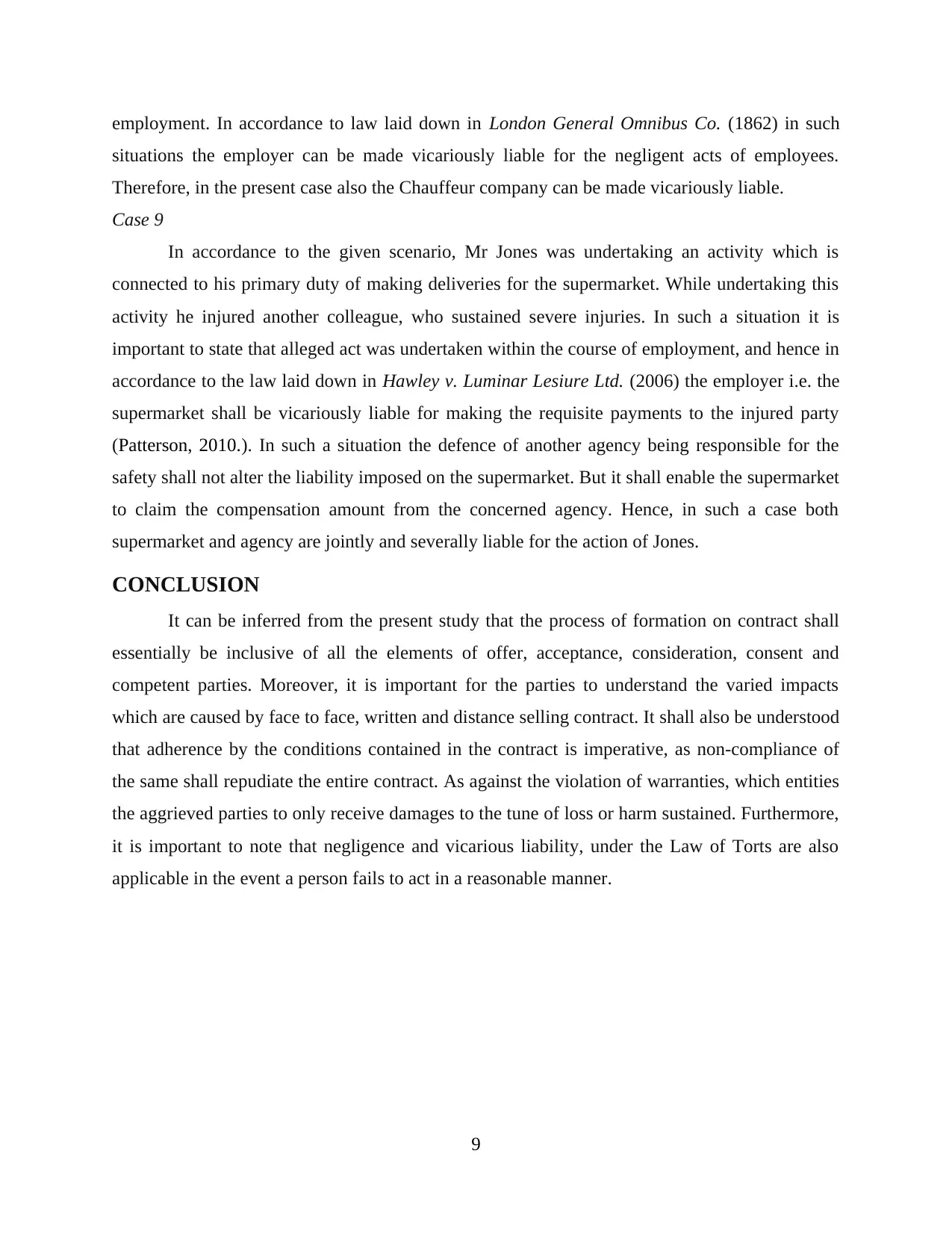
employment. In accordance to law laid down in London General Omnibus Co. (1862) in such
situations the employer can be made vicariously liable for the negligent acts of employees.
Therefore, in the present case also the Chauffeur company can be made vicariously liable.
Case 9
In accordance to the given scenario, Mr Jones was undertaking an activity which is
connected to his primary duty of making deliveries for the supermarket. While undertaking this
activity he injured another colleague, who sustained severe injuries. In such a situation it is
important to state that alleged act was undertaken within the course of employment, and hence in
accordance to the law laid down in Hawley v. Luminar Lesiure Ltd. (2006) the employer i.e. the
supermarket shall be vicariously liable for making the requisite payments to the injured party
(Patterson, 2010.). In such a situation the defence of another agency being responsible for the
safety shall not alter the liability imposed on the supermarket. But it shall enable the supermarket
to claim the compensation amount from the concerned agency. Hence, in such a case both
supermarket and agency are jointly and severally liable for the action of Jones.
CONCLUSION
It can be inferred from the present study that the process of formation on contract shall
essentially be inclusive of all the elements of offer, acceptance, consideration, consent and
competent parties. Moreover, it is important for the parties to understand the varied impacts
which are caused by face to face, written and distance selling contract. It shall also be understood
that adherence by the conditions contained in the contract is imperative, as non-compliance of
the same shall repudiate the entire contract. As against the violation of warranties, which entities
the aggrieved parties to only receive damages to the tune of loss or harm sustained. Furthermore,
it is important to note that negligence and vicarious liability, under the Law of Torts are also
applicable in the event a person fails to act in a reasonable manner.
9
situations the employer can be made vicariously liable for the negligent acts of employees.
Therefore, in the present case also the Chauffeur company can be made vicariously liable.
Case 9
In accordance to the given scenario, Mr Jones was undertaking an activity which is
connected to his primary duty of making deliveries for the supermarket. While undertaking this
activity he injured another colleague, who sustained severe injuries. In such a situation it is
important to state that alleged act was undertaken within the course of employment, and hence in
accordance to the law laid down in Hawley v. Luminar Lesiure Ltd. (2006) the employer i.e. the
supermarket shall be vicariously liable for making the requisite payments to the injured party
(Patterson, 2010.). In such a situation the defence of another agency being responsible for the
safety shall not alter the liability imposed on the supermarket. But it shall enable the supermarket
to claim the compensation amount from the concerned agency. Hence, in such a case both
supermarket and agency are jointly and severally liable for the action of Jones.
CONCLUSION
It can be inferred from the present study that the process of formation on contract shall
essentially be inclusive of all the elements of offer, acceptance, consideration, consent and
competent parties. Moreover, it is important for the parties to understand the varied impacts
which are caused by face to face, written and distance selling contract. It shall also be understood
that adherence by the conditions contained in the contract is imperative, as non-compliance of
the same shall repudiate the entire contract. As against the violation of warranties, which entities
the aggrieved parties to only receive damages to the tune of loss or harm sustained. Furthermore,
it is important to note that negligence and vicarious liability, under the Law of Torts are also
applicable in the event a person fails to act in a reasonable manner.
9
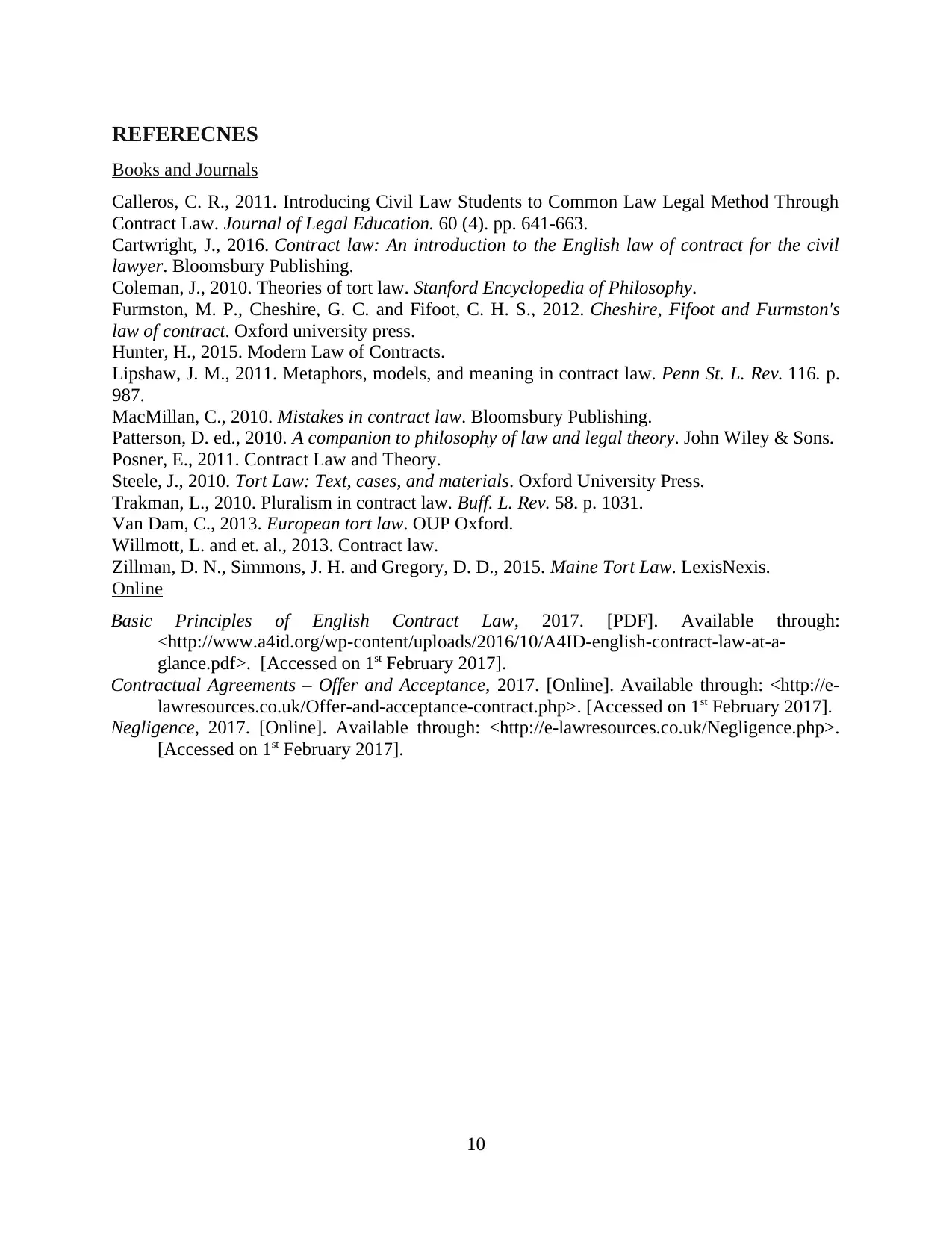
REFERECNES
Books and Journals
Calleros, C. R., 2011. Introducing Civil Law Students to Common Law Legal Method Through
Contract Law. Journal of Legal Education. 60 (4). pp. 641-663.
Cartwright, J., 2016. Contract law: An introduction to the English law of contract for the civil
lawyer. Bloomsbury Publishing.
Coleman, J., 2010. Theories of tort law. Stanford Encyclopedia of Philosophy.
Furmston, M. P., Cheshire, G. C. and Fifoot, C. H. S., 2012. Cheshire, Fifoot and Furmston's
law of contract. Oxford university press.
Hunter, H., 2015. Modern Law of Contracts.
Lipshaw, J. M., 2011. Metaphors, models, and meaning in contract law. Penn St. L. Rev. 116. p.
987.
MacMillan, C., 2010. Mistakes in contract law. Bloomsbury Publishing.
Patterson, D. ed., 2010. A companion to philosophy of law and legal theory. John Wiley & Sons.
Posner, E., 2011. Contract Law and Theory.
Steele, J., 2010. Tort Law: Text, cases, and materials. Oxford University Press.
Trakman, L., 2010. Pluralism in contract law. Buff. L. Rev. 58. p. 1031.
Van Dam, C., 2013. European tort law. OUP Oxford.
Willmott, L. and et. al., 2013. Contract law.
Zillman, D. N., Simmons, J. H. and Gregory, D. D., 2015. Maine Tort Law. LexisNexis.
Online
Basic Principles of English Contract Law, 2017. [PDF]. Available through:
<http://www.a4id.org/wp-content/uploads/2016/10/A4ID-english-contract-law-at-a-
glance.pdf>. [Accessed on 1st February 2017].
Contractual Agreements – Offer and Acceptance, 2017. [Online]. Available through: <http://e-
lawresources.co.uk/Offer-and-acceptance-contract.php>. [Accessed on 1st February 2017].
Negligence, 2017. [Online]. Available through: <http://e-lawresources.co.uk/Negligence.php>.
[Accessed on 1st February 2017].
10
Books and Journals
Calleros, C. R., 2011. Introducing Civil Law Students to Common Law Legal Method Through
Contract Law. Journal of Legal Education. 60 (4). pp. 641-663.
Cartwright, J., 2016. Contract law: An introduction to the English law of contract for the civil
lawyer. Bloomsbury Publishing.
Coleman, J., 2010. Theories of tort law. Stanford Encyclopedia of Philosophy.
Furmston, M. P., Cheshire, G. C. and Fifoot, C. H. S., 2012. Cheshire, Fifoot and Furmston's
law of contract. Oxford university press.
Hunter, H., 2015. Modern Law of Contracts.
Lipshaw, J. M., 2011. Metaphors, models, and meaning in contract law. Penn St. L. Rev. 116. p.
987.
MacMillan, C., 2010. Mistakes in contract law. Bloomsbury Publishing.
Patterson, D. ed., 2010. A companion to philosophy of law and legal theory. John Wiley & Sons.
Posner, E., 2011. Contract Law and Theory.
Steele, J., 2010. Tort Law: Text, cases, and materials. Oxford University Press.
Trakman, L., 2010. Pluralism in contract law. Buff. L. Rev. 58. p. 1031.
Van Dam, C., 2013. European tort law. OUP Oxford.
Willmott, L. and et. al., 2013. Contract law.
Zillman, D. N., Simmons, J. H. and Gregory, D. D., 2015. Maine Tort Law. LexisNexis.
Online
Basic Principles of English Contract Law, 2017. [PDF]. Available through:
<http://www.a4id.org/wp-content/uploads/2016/10/A4ID-english-contract-law-at-a-
glance.pdf>. [Accessed on 1st February 2017].
Contractual Agreements – Offer and Acceptance, 2017. [Online]. Available through: <http://e-
lawresources.co.uk/Offer-and-acceptance-contract.php>. [Accessed on 1st February 2017].
Negligence, 2017. [Online]. Available through: <http://e-lawresources.co.uk/Negligence.php>.
[Accessed on 1st February 2017].
10
⊘ This is a preview!⊘
Do you want full access?
Subscribe today to unlock all pages.

Trusted by 1+ million students worldwide
1 out of 12
Related Documents
Your All-in-One AI-Powered Toolkit for Academic Success.
+13062052269
info@desklib.com
Available 24*7 on WhatsApp / Email
![[object Object]](/_next/static/media/star-bottom.7253800d.svg)
Unlock your academic potential
Copyright © 2020–2025 A2Z Services. All Rights Reserved. Developed and managed by ZUCOL.





